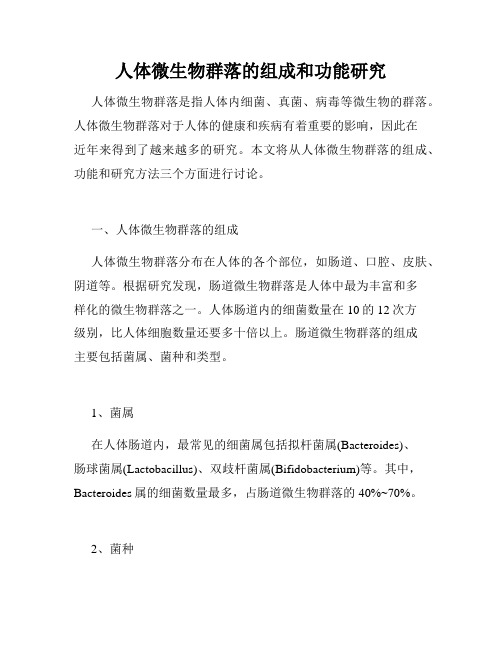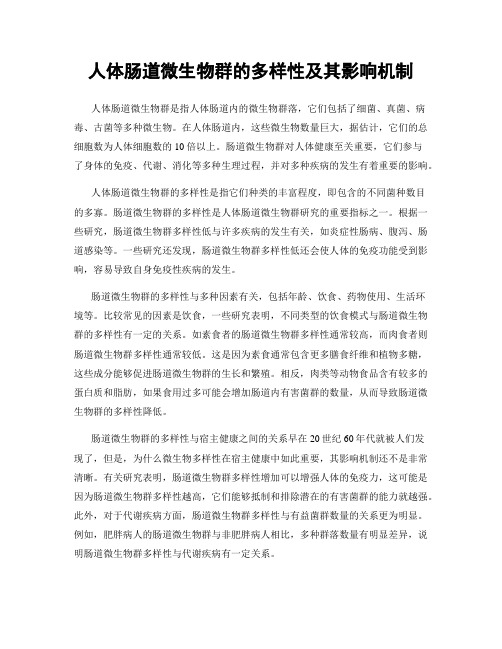人体细胞和肠道微生物数量
肠道代谢组学

百泰派克生物科技
肠道代谢组学
肠道代谢组学又称肠道微生物代谢组学,是研究机体肠道内所有微生物及其代谢物的科学。
人体肠道内分布有高达100万亿个细菌,其数量接近自身细胞的10倍,
基因组总量约为自身基因数目的150倍,有人体“第二基因组”之称,肠道的微生物菌群也被称为人体另一个“器官”。
肠道微生物主要通过其小分子代谢物与宿主进行密切的信息交流和相互作用,在代谢、免疫、疾病以及神经系统发展和调控中起到了重要作用,影响着宿主的消化吸收能力、抵御感染风险的能力以及宿主对疾病治疗药物的反应,与机体健康和疾病密切相关。
肠道微生物代谢组学运用代谢组学技术分析肠菌代谢物的动态变化,旨在寻找与宿主病理生理变化相关的肠道微生物关键代谢物,确定与某项疾病相关的生物标志物,为临床诊断提供新的方法,为进一步治疗提供新的方向和思路。
百泰派克生物科技采用Thermo公司最新推出的Obitrap Fusion Lumos质谱平台结合Nano-LC色谱,提供非靶向代谢组学服务技术包裹,可对多种样品如肠道微生物、血清、尿液、体液、脑脊液等进行代谢物分析,欢迎免费咨询。
人体肠道微生态 生命早期微生物对健康的意义

(11)、2015年,Dachuan Zhang等研究表明, 肠道菌群通过TLR及MyD88信号通路介导中性粒细 胞的衰老;如果清除肠道菌群会导致循环中的衰老 中性粒细胞显着减少,并增加了炎症相关的器官损 伤
(12)、2014年,Manon DSchulz等在K-ras小 鼠身上证明,高脂饮食可以促进小肠肿瘤发生且与 肥胖无关。 (13)、2014年,Nan Qin等构建了肝硬化患者 肠道菌群基因组,找到了66个代表细菌物种的MGS, 其中28个在患者组中富集,38个在健康组中富集, 并根据各基因标记物定义了肝硬化病人区别指数
5 抗肿瘤作用
双歧杆菌是肠道菌群中的主力军,具有显着的抗癌 作用,能够直接或间接清除致癌物质,使致癌物质 失活: 抑制肠道内腐败菌产生的致癌酶;降低肠道pH值, 促进肠道蠕动,缩短致癌物质与肠道接触时间,促 进致癌物质的排放。
(1)、与减肥后反弹有关:2016年,Christoph A Thaiss等发现给予节食减重的小鼠高脂饮食后,促 进了更快的体重反弹和代谢失常;将此类鼠的菌群 移植到无菌小鼠并给予高脂饮食时,与移植正常菌 群的小鼠相比体重增加更快。 (2)、2016年,Martina Sassone-Crosi等研究 发现有益菌EcN可以分泌具有抗菌活性的蛋白 microcin,该蛋白可以抑制炎症肠道中肠杆菌的扩 增,使炎症程度减轻
(14)、2012年,Junjie Qin等利用宏基因组相 关研究的方法,最终确定了可用于二型糖尿病分类 的23个肠道生物标记物 (15)、2011年,Andrew LKau等利用宏基因组 学和无菌动物,阐释了饮食、营养、肠道菌群和宿 主免疫系统之间的关系,说明肠道菌群与人类健康 息息相关。
微生物与肠道健康的关系

微生物与肠道健康的关系近年来,越来越多的研究证明了微生物与肠道健康之间的密切关系。
微生物是存在于人体肠道内的一类微小生物体,包括细菌、真菌、病毒等。
与人体共生共存,它们对于维持人体健康起着重要的作用。
本文将会探讨微生物与肠道健康之间的关系以及其对健康的影响。
一、微生物在肠道中的种类和数量人体肠道内的微生物种类繁多,据估计有超过1000种不同的细菌。
其中最主要的是益生菌和有益微生物。
益生菌是一类有助于人体健康的微生物,如乳酸菌和双歧杆菌。
这些益生菌能够抑制有害菌的生长,维持肠道内微生物的平衡。
此外,正常情况下,肠道中的微生物数量极其庞大。
据研究,人体肠道内细菌的数量可以达到数万亿的级别,远远超过人体细胞的数量。
这些微生物可以通过帮助人体消化食物、合成维生素和调节免疫功能等方式对人体发挥重要的作用。
二、微生物对肠道健康的重要作用微生物对于肠道健康有着重要的影响。
首先,它们能够帮助人体消化食物。
肠道中的微生物可以分解难以被人体消化的食物成分,使其更易为身体吸收利用。
这不仅有助于提高营养吸收效率,还可以减轻胃肠道的负担,预防消化系统疾病的发生。
其次,微生物在肠道内还能合成一些人体无法自行合成的维生素和氨基酸。
例如,肠道内的某些细菌可以合成维生素K,它对凝血功能起着至关重要的作用。
此外,微生物还能够产生短链脂肪酸,这些酸对于维持肠黏膜的健康起着重要作用。
另外,微生物还对免疫系统起着重要的调节作用。
肠道是人体最大的免疫器官之一,肠道内的微生物能够通过调节免疫细胞的活性和分泌免疫因子等方式影响整体免疫功能。
一些研究表明,有益菌种可以增强人体免疫系统的应对能力,降低感染和炎症性肠道疾病的风险。
三、微生物失衡与肠道健康问题当肠道内的微生物失衡时,肠道健康问题可能会出现。
微生物失衡又称为肠道菌群失调,指肠道内益生菌和有益微生物数量减少,同时有害菌数量增加的情况。
此时,肠道内的微生物群落失去平衡,可能导致多种健康问题的出现。
肠道微生物群与人类健康的关系

肠道微生物群与人类健康的关系肠道微生物群是指存在于人类肠道中的微生物种群,其数量约为10至100万亿个细胞,包括多种细菌、真菌和病毒等。
这些微生物群有着重要的生理功能,对于维持肠道的健康和促进人类健康都起着至关重要的作用,是时下热门研究的主题之一。
一、肠道微生物群的构成肠道微生物群是由多种不同物种的微生物组成的,其中包括细菌、真菌、病毒等等。
其中,最重要的是细菌,约占全部微生物群的90%以上。
根据不同的研究方法和研究对象,肠道微生物群的种类和数量会有所不同,但总的来说,大约有1000个不同的细菌物种存在于人类的肠道中,其中包括常见的双歧杆菌、乳酸菌、产酸杆菌等等。
二、肠道微生物群的作用1.帮助消化肠道微生物群中的细菌和真菌可以帮助消化食物,尤其是那些难以消化的成分,如多糖类物质等等。
2.调节免疫系统肠道微生物群也与人类的免疫系统密切相关,可以调节免疫系统的功能,增强人体的抵抗力,减少感染、过敏等疾病的发生。
3.维持肠道健康肠道微生物群可以保持肠道内的平衡状态,减少有害细菌的生长,维持肠道的健康状态。
4.影响心理健康肠道微生物群也可以影响人类的心理健康,有研究发现,肠道微生物群的不平衡与焦虑、抑郁等心理疾病密切相关。
三、肠道微生物群与健康的关系由于肠道微生物群对人类健康的影响极大,因此,近年来有越来越多的研究关注与这个领域。
这些研究表明,肠道微生物群与人类健康存在着密切的关系,从肠道健康到人类疾病的治疗,肠道微生物群都扮演着极为重要的角色。
1.肠道健康肠道微生物群是维持肠道健康的重要因素,如果肠道微生物群存在着明显的不平衡,就会导致肠道疾病的发生,如肠炎、胃炎等等。
2.肥胖有研究表明,肠道微生物群与人类肥胖的发生也存在着一定的关系。
肥胖者的肠道微生物群通常存在着一定的不平衡,这些微生物可以直接或间接地影响人类体重。
3.炎症性疾病另外,肠道微生物群还可以影响人类炎症性疾病的发生和治疗。
一些炎症性肠病和肝病的治疗,已经利用了肠道微生物群调节的方法。
肠道微生态研究的进展与应用

肠道微生态研究的进展与应用肠道微生态是指肠道内的微生物群落和它们与人体的相互作用关系。
肠道微生态在人类健康的维持和疾病防治中扮演重要的角色。
随着分子生物学、生物信息学和生物技术等领域的不断发展,肠道微生态研究已经取得了很大的进展,并在临床应用上有着广泛的前景。
一、肠道微生态的概念和意义肠道微生态包括肠道内微生物的多样性和数量,以及肠道细胞和微生物之间的相互作用。
人类肠道内的微生物群落多种多样,其数量已经超过人体细胞总数的10倍,其中包括细菌、真菌、病毒和寄生虫等。
这些微生物在维持人体健康和发挥疾病预防、治疗作用中起到重要的作用。
例如,肠道微生物可以帮助人体消化吸收食物、产生维生素和短链脂肪酸等营养物质,还可以抑制有害菌的生长和扩散、促进肠道免疫系统的发育和功能、调节消化、吸收和代谢等生理功能。
肠道微生态失调与多种疾病的发生和发展密切相关,例如肠炎、炎症性肠病、超敏反应性肠道症、自身免疫性病变、肥胖症、代谢综合征、牙周病等。
因此,肠道微生态的研究和调节在临床治疗和健康管理中具有极大的意义。
二、肠道微生态研究的方法和技术1.高通量测序技术高通量测序技术是肠道微生态研究中最常用的方法之一,它可以以很高的精度和效率对肠道微生物群落的结构及其基因组信息进行分析和鉴定。
该技术可以通过对微生物DNA片段进行PCR 扩增和总DNA提取,再通过高通量测序仪进行测序得出微生物群落组成信息。
这种方法可突破传统培养方法的局限性,对未知微生物进行鉴定,同时可以分析微生物基因组和代谢途径等方面的信息。
2.荧光原位杂交(FISH)技术FISH技术使用特异性荧光探针标记特定的微生物,以便在肠道中直接观察不同微生物的分布和数量。
该方法可以用于分离无法进行高通量测序的特定类群微生物,并可对微生物的生长、形态和代谢途径等特性进行研究。
3.16S rRNA分析技术16S rRNA是微生物基因组中高度保守的区域之一,在不同菌种中存在着较大的变异性,因此可用于微生物分类和系统进化研究。
人体微生物群落的组成和功能研究

人体微生物群落的组成和功能研究人体微生物群落是指人体内细菌、真菌、病毒等微生物的群落。
人体微生物群落对于人体的健康和疾病有着重要的影响,因此在近年来得到了越来越多的研究。
本文将从人体微生物群落的组成、功能和研究方法三个方面进行讨论。
一、人体微生物群落的组成人体微生物群落分布在人体的各个部位,如肠道、口腔、皮肤、阴道等。
根据研究发现,肠道微生物群落是人体中最为丰富和多样化的微生物群落之一。
人体肠道内的细菌数量在10的12次方级别,比人体细胞数量还要多十倍以上。
肠道微生物群落的组成主要包括菌属、菌种和类型。
1、菌属在人体肠道内,最常见的细菌属包括拟杆菌属(Bacteroides)、肠球菌属(Lactobacillus)、双歧杆菌属(Bifidobacterium)等。
其中,Bacteroides属的细菌数量最多,占肠道微生物群落的40%~70%。
2、菌种在肠道微生物群落中,不同的菌种有着不同的生态功能和代谢特性。
例如,Bifidobacterium bifidum是一种常见的乳酸菌,能够产生有利于人体健康的丙酸、乳酸等物质。
3、类型人体微生物群落可以分为两大类,即有益菌和有害菌。
有益菌可以帮助人体保持生态平衡,有害菌则可能会导致人体发生疾病。
例如,育龄期女性的阴道内微生物群落类型应以乳酸杆菌群为主,当乳酸杆菌群降低时将容易导致细菌性阴道病。
二、人体微生物群落的功能人体微生物群落在人体中起到多种多样的生态功能和代谢特性,包括:1、合成维生素和其他营养物质部分肠道微生物群落能够合成多种维生素,如双歧杆菌能够合成维生素B12。
此外,肠道微生物群落还能够参与有机物质的分解、生成等过程。
2、维持肠道功能肠道微生物群落对于人体肠道功能的正常维护和运作具有重要的作用。
微生物能够激活和支持肠道上皮细胞,促进肠道黏膜修复,促进肠道蠕动,防止肠道炎症和肠易激综合征等疾病的发生。
3、调节免疫功能人体微生物群落能够调节机体免疫反应,维持免疫平衡。
人类肠道内微生物的多样性和功能研究

人类肠道内微生物的多样性和功能研究人体肠道内存在着成千上万种微生物,这些微生物被称为肠道菌群,它们与人体的健康密切相关。
近年来,随着技术的发展,人们对肠道微生物进行了更深入和全面的研究,对其多样性和功能有了更深刻的认识。
一、肠道微生物种类和数量肠道微生物包括细菌、真菌、病毒和寄生虫等,其中以细菌数量最多。
目前已经发现了超过1000种肠道细菌,其中大部分属于 Firmicutes、Bacteroidetes、Actinobacteria、Proteobacteria 等菌门。
有研究表明,肠道中的微生物数量可达到10^14个/克肠道内容物,这个数字比人类细胞数量还多。
同时,人体中的微生物数量也达到了人体细胞数量的10倍以上。
这些数字表明,人类肠道微生物数量庞大,与人类健康密切相关。
二、肠道微生物的功能(一)有益功能1.帮助消化吸收营养物质肠道微生物可以分解和转化食物中的一些难以消化的物质,如纤维素、淀粉和部分蛋白质等,生产出营养物质和代谢产物,如短链脂肪酸等,对人体健康有益。
2.维护肠道屏障功能肠道微生物可以维护肠道黏膜屏障功能,形成了一层菌膜,保护黏膜表面不被有害菌和毒素侵袭。
另外,这些微生物还能产生抗菌素和酸性物质,防止病原体入侵,提高肠道免疫力。
3.调节免疫系统肠道微生物可以通过多种途径调节宿主免疫系统,诱导和维持肠道和全身免疫平衡。
一些研究表明,肠道微生物可以调节宿主T细胞、巨噬细胞和树突状细胞等免疫细胞的活性和分化,有助于预防和治疗免疫相关疾病。
4.调节心理行为最近的研究表明,肠道微生物还能与中枢神经系统相互作用,通过肠-脑轴调节心理行为。
研究表明,改变肠道微生物组成可以影响宿主行为,如抑郁、焦虑等。
(二)有害功能如果肠道微生物失去平衡、数量失调或种类异常,就会对人体健康产生不利影响。
例如,出现形态独特的群集(如菌落细菌),易形成菌株间和菌株之间的生态隔离,致使肠道菌群发生改变,易导致机体免疫调节失衡,进而导致多种疾病的发生。
人体肠道微生物群的多样性及其影响机制

人体肠道微生物群的多样性及其影响机制人体肠道微生物群是指人体肠道内的微生物群落,它们包括了细菌、真菌、病毒、古菌等多种微生物。
在人体肠道内,这些微生物数量巨大,据估计,它们的总细胞数为人体细胞数的10倍以上。
肠道微生物群对人体健康至关重要,它们参与了身体的免疫、代谢、消化等多种生理过程,并对多种疾病的发生有着重要的影响。
人体肠道微生物群的多样性是指它们种类的丰富程度,即包含的不同菌种数目的多寡。
肠道微生物群的多样性是人体肠道微生物群研究的重要指标之一。
根据一些研究,肠道微生物群多样性低与许多疾病的发生有关,如炎症性肠病、腹泻、肠道感染等。
一些研究还发现,肠道微生物群多样性低还会使人体的免疫功能受到影响,容易导致自身免疫性疾病的发生。
肠道微生物群的多样性与多种因素有关,包括年龄、饮食、药物使用、生活环境等。
比较常见的因素是饮食,一些研究表明,不同类型的饮食模式与肠道微生物群的多样性有一定的关系。
如素食者的肠道微生物群多样性通常较高,而肉食者则肠道微生物群多样性通常较低。
这是因为素食通常包含更多膳食纤维和植物多糖,这些成分能够促进肠道微生物群的生长和繁殖。
相反,肉类等动物食品含有较多的蛋白质和脂肪,如果食用过多可能会增加肠道内有害菌群的数量,从而导致肠道微生物群的多样性降低。
肠道微生物群的多样性与宿主健康之间的关系早在20世纪60年代就被人们发现了,但是,为什么微生物多样性在宿主健康中如此重要,其影响机制还不是非常清晰。
有关研究表明,肠道微生物群多样性增加可以增强人体的免疫力,这可能是因为肠道微生物群多样性越高,它们能够抵制和排除潜在的有害菌群的能力就越强。
此外,对于代谢疾病方面,肠道微生物群多样性与有益菌群数量的关系更为明显。
例如,肥胖病人的肠道微生物群与非肥胖病人相比,多种群落数量有明显差异,说明肠道微生物群多样性与代谢疾病有一定关系。
除了多样性,丰度也是人们关注的重点之一,丰度是指某一菌群数量的多寡,它也是肠道微生物群的关键指标之一。
肠道细菌

肠道细菌——一个被遗忘的“功能器官”专题调研报告成人胃肠道粘膜表面积达到300 m2,是与外界环境发生相互作用的最大区域。
在成人胃肠道中定殖着约1014个微生物,其数量是人体体细胞总数的10倍。
正常情况下,成人肠道菌群重量超过1 kg,编码约330万个特异基因,是人类基因组编码基因数的150多倍。
尽管人类不同个体间基因组的差异只有0.1%左右,但不同个体间肠道微生物组的差异可以达到80–90%。
定殖在宿主肠道中的菌群,在发挥宿主生理功能上起着非常重要的作用,包括从食物中摄取能量、产生重要的代谢产物、促进免疫系统的发育与成熟、保护宿主免受病原的感染等。
肠道菌群反过来也会受到宿主遗传因子、饮食习惯和环境因素等的影响,使得肠道菌群具有多样性和宿主特异性。
随着DNA测序技术和生物信息学技术突飞猛进的发展,更好地研究和了解肠道菌群在各种疾病,如肥胖、糖尿病、IBS、IBD、结肠癌和代谢综合症等疾病中的重要作用,将为我们采取更为有效的防治措施提供指导。
一、正常人体的肠道微生物组成在各国人类微生物基因组计划的大力推动下,人们开始对定殖在我们肠道中并不起眼的微生物有了全新的认识。
研究表明平均每个人肠道中定殖的细菌总数估计约有1000种,而对整个人群来讲,可以达到10,000到40,000种。
人体肠道菌群是一个复杂的生态系统,包括细菌、古菌、酵母和纤维状真菌。
古菌和真菌各自只代表单独的一个门,而人胃肠道中的细菌却非常富有多样性。
人们已经在人胃肠中检测到了9个细菌门,其中硬壁菌门(Firmicutes )、拟杆菌门(Bacteroidetes )和放线菌门(Actinobacteria )占优势。
变形菌门(Proteobacteria )的细菌也很常见,但含量相对较低。
肠道细菌的数量和组成与不同的解剖部位也有关,在人体肠道的不同部位其微生态环境和所定殖细菌的数量与组成也存在着明显的差异。
二、肠道菌群的功能人体胃肠道中定居着100万亿的细菌和古菌,与宿主存在着共生关系,共同维护着宿主的生理平衡。
肠道微生物

肠道微生物在人体肠道中生活着数以万亿的共生菌群,它们的种类繁多,可达上千种,数量也很惊人,是人体细胞总量的10倍以上,迄今为止,仍有80%以上的微生物不为人知。
这些肠道微生物和人体存在着互利共生的关系,对于维持人类的健康发挥着重要的作用。
当肠道内平衡因某些因素被打破致使肠道菌群发生紊乱时,人体就可能患上诸如肥胖症、糖尿病、肠炎甚至癌症等疾病。
随着现代分子生物技术的蓬勃发展,已解决了不可培养微生物研究的难题,使得肠道微生物的研究进入一个新的阶段,NGS高通量测序技术的发展,研究者可以基于16S rDNA/18S rDNA基因,利用二代测序(Next Generation Sequencing,NGS)技术(454 GS FLX,Illimina HiSeq、MiSeq),获得庞大的数据信息,通过生物信息学手段,来分析肠道微生物的多样性,通过统计分析,对大量数据进行PCA和PCoA分析,得出发病前后样本间肠道微生物主要组成成分是否存在差异;并进一步通过RDA分析,找到与环境因子(疾病等)相关的微生物群落组成,从而达到预防疾病的发生的目的。
研究案例:1、结直肠癌与肠道微生物Tingting Wang等采用454测序技术研究结直肠癌(CRC)患者与正常人群肠道微生物的菌落组成差异。
并结合real-time PCR对相关基因进行分析,最终确定丁酸盐产生菌的减少和一些致病微生物的增加使得CRC患者肠道微生物菌落的失衡。
Structural segregation of gut microbiota between colorectal cancer patients and healthy volunteers. 2012. The ISME Journal研究对象: CRC患者46人,健康人群56人研究区域:V3区测序平台:Roche 454 GS FLX主要结果:(1)PCA主成分分析(图a)和PCoA主坐标分析(图b)显示CRC患者与正常人肠道微生物存在差异。
科学家揭示肠道微生物对人体健康的影响

科学家揭示肠道微生物对人体健康的影响肠道微生物,是指人体肠道内的各种微小生物,包括细菌、病毒和真菌等。
这些微生物的种类和数量非常丰富,会受到饮食、药物等多种因素影响。
最近,科学家们发现,肠道微生物与人体健康密切相关,其影响可能超出我们的想象。
一、肠道微生物的重要性人类的肠道微生物数量和人体细胞数量大致相等。
这些微生物具有极为复杂的生态系统,与人体的健康密切相关。
它们可以帮助人体消化食物、合成维生素和蛋白质等,同时还有助于维持肠壁的完整性和免疫系统的正常功能。
此外,肠道微生物还参与调节人体的代谢过程和情绪调节等重要活动。
二、肠道微生物的影响因素肠道微生物的种类和数量会受到多种因素的影响,其中最主要的包括以下几个:1.饮食:不同的饮食会对肠道微生物的种类和数量产生明显影响。
比如,富含膳食纤维的食物可以促进肠道微生物的生长,而高油、高糖的饮食则会对微生物生态系统造成负担。
2.药物:许多药物,如抗生素、抗炎药、抗肿瘤药等,都会对肠道微生物的种类和数量产生严重影响。
长期的药物使用甚至可能引起肠道微生态系统崩溃,导致严重的健康问题。
3.生活环境:环境污染、压力、沉睡不足等生活因素也会影响人体肠道微生物,这些造成的影响极大程度上会改变微生物群落的动态平衡。
三、肠道微生物与健康的关系肠道微生物与人体健康密切相关,它们主要通过以下几个方面来维护人体的健康:1.营养吸收:肠道微生物可以帮助人体消化和吸收营养,这对于保持健康至关重要。
2.免疫系统:微生物还可以激活和调节人体免疫反应,帮助维护免疫系统功能的正常。
3.代谢调节:肠道微生物还能影响人体的代谢率和能量利用率,这对于肥胖、糖尿病等代谢性疾病的预防和治疗也具有重要作用。
最近的研究还表明,肠道微生物与大脑之间存在着复杂的相互作用。
肠道微生物与人体大脑之间有着高度的交流和相互影响,对于人体的情感、情绪都有深远影响。
这一新的研究领域被称为“肠脑轴”。
四、肠道微生物对健康的负面影响肠道微生物如果失衡,可能会对人体健康产生负面影响。
肠道微生物在健康中的作用

肠道微生物在健康中的作用随着生活水平的提高,人们越来越注重健康保健。
除了饮食习惯和运动方式外,肠道微生物也越来越受到人们的关注。
肠道微生物是指在人类肠道内生活的各种微生物,包括细菌、真菌、病毒等。
这些微生物对人体健康有着重要的影响。
本文将从肠道微生物的种类、作用以及调节方法等方面详细探讨。
肠道微生物的种类肠道微生物在人体中的数量很多,其主要分布在大肠和小肠中。
有人认为,肠道微生物种类数量与人体细胞数量相等,其中菌类占据大多数,其中有80%的细菌属于三个主要门类:厌氧菌门(如双歧杆菌、链球菌等)、变形菌门(如大肠杆菌、鲍曼不动杆菌等)和放线菌门(如放线菌、微球菌等)。
肠道微生物的作用肠道微生物不仅在消化系统中可以发现,他们对身体的其他系统也非常重要。
人类肠道内微生物的种类和数量与人的健康有密切关系,其重要的作用包括:1. 消化:肠道微生物可以促进碳水化合物和蛋白质的消化,并生成抗氧化剂、B族维生素等物质。
这些物质可以加强身体免疫力、预防癌症、心脑血管疾病和肠胃疾病等疾病。
2. 营养:肠道微生物在人体中并不是人体可以直接获取的营养物,但是,它可以通过合成维生素、磷脂、矿物质等,为身体提供健康所需的营养。
3. 免疫调节:肠道微生物可以产生抗体、抗炎物质和免疫调节剂等物质,从而增强人体的免疫力,预防疾病的发生。
4. 均衡微生态:人体内存在微生物的平衡状态。
当身体中一些因素改变时,微生物可能会失衡,导致小肠综合征、肠炎等疾病的发生。
调节肠道微生物平衡的方法肠道微生物对于人体健康的作用是密不可分的。
当肠道微生态被破坏时,人们通过调节如饮食、药物、习惯等,帮助体内的微生物重新达到一个平衡状态,以保持身体健康。
1. 饮食:可以通过饮食来优化肠道微生态,适当加入高纤维、天然优酸乳等食品。
高纤维食品可以刺激肠道蠕动,排除堆积在肠道内的毒素和废物;而天然优酸乳中含有大量的益生菌,可以有助于肠道菌群的平衡。
2. 药物:常用口服抗生素、激素等药物,都会对肠道微生物产生影响。
体内微生物:你的第二个基因库

体内微生物:你的第二个基因库在我们每个人的身体内部,潜藏着一个庞大而复杂的生态系统,那就是人体微生物群。
这些微生物不仅是我们身体的一部分,还是我们健康和生理功能的重要参与者。
近年来,科学研究不断揭示体内微生物与人类健康之间的紧密关系,让微生物群成为我们理解自身生理、疾病机制以及治疗方法的重要新视角。
可以说,体内微生物已被称为“你的第二个基因库”。
微生物群的组成人体内的微生物种类繁多,包括细菌、真菌、病毒、单细胞生物等。
根据最近的研究估计,人体内的微生物数量大约是人体细胞数量的十倍,因此,体内微生物在基因表达和代谢过程中发挥着不可或缺的作用。
根据不同的人体部位,微生物群也会有所不同。
口腔、肠道、皮肤及阴道等区域都有各自特定的微生物组成。
例如,肠道微生物以细菌为主,包括乳酸菌、双歧杆菌、大肠杆菌等;而皮肤上则覆盖着一些保护皮肤不受病原体侵袭的酵母和皮肤细菌。
微生物群与健康随着对微生物群研究的深入,科学家们发现这些小生物与人类健康状况密切关联。
以下是几个方面:1. 免疫系统人体的免疫系统与肠道内的微生物相互依存。
良好的肠道微生物群能够促进免疫细胞的生成并调节免疫反应,从而提高抵抗力。
相反,当肠道微生物失衡时,会导致免疫功能下降,易感染或出现自体免疫疾病。
2. 消化与营养吸收肠道内有丰富的微生物可以帮助分解食物中的复杂碳水化合物、纤维以及某些维他命,并通过代谢作用将其转化为我们身体所需的能量和营养成分。
例如,一些特定细菌能够合成维他命K和某些B族维生素,从而在营养吸收方面起到至关重要的作用。
3. 代谢与肥胖越来越多的研究表明,肠道微生物与代谢疾病如肥胖、糖尿病之间存在关联。
一些特定类型的细菌能够影响脂肪储存、食欲控制和能量消耗,这对肥胖症的发展有很大的影响。
因此,通过调节微生物群,有望成为缓解肥胖及其相关疾病的一种有效手段。
4. 精神健康近年来,科学发现肠道微生物与心理健康也有显著联系,通过“肠脑轴”(gut-brain axis)关系,两者紧密相连。
肠道微生物影响人体身心健康

肠道微生物影响人体身心健康摘要】肠道内有数量众多、种类丰富的微生物,它们和宿主间形成了互利共生的关系,对人体的身心健康产生着重大影响。
近年来,随着对肠道微生物作用研究的不断深入,发现肠道菌群微生物不仅影响身体健康,还影响人们心理健康。
最后指出补充益生菌是治疗身心疾病的有效手段。
【关键词】肠道微生物;益生菌;身体健康;心理健康【中图分类号】R37 【文献标识码】A 【文章编号】1007-8231(2018)04-0350-021.肠道中的共生微生物与人体体表相比,消化道是人与外来环境接触最多的管道,起自口腔延续为咽、食管、胃、小肠、大肠、止于肛门。
其中口腔作为进食的主要通道,口腔内的腺体分泌唾液,食物借唾液的润滑作用通过食管,唾液中的唾液淀粉酶分解部分碳水化合物。
咽作为呼吸道和消化道的共同通道,主要完成吞咽这一动作。
食管是其中一条肌性管道,全长约25~30cm,其中有3个狭窄部位,且极易滞留食物,是食管癌的好发部位,防止呼吸时空气进入食管,以及阻止胃内容物逆流入食管。
胃分为贲门、胃底、胃体和胃窦四个部分。
胃的总容量约1000~3000ml,其黏膜中含有大量腺体,分泌胃液,呈酸性……小肠位于腹腔内,上连幽门,下接盲肠,全长4~6m分为十二指肠、空场、回肠3部分,具有极强的消化功能,小肠黏膜延伸性极强,具有环形皱襞,拥有大量绒毛,消化道表面积极大,达200~300m2。
肠道内存在着大量的微生物,肠道不仅是人体消化吸收的重要场所,也是最大的免疫器官,可以维持正常免疫防御功能,为微生物提供了良好的栖息环境,肠道内微生物数量高达1014个,接近人体细胞数量的10倍,质量高达1.2kg,接近人体肝脏的质量其包含的基因数目约是自身的100倍,具有人体自身不具备的代谢功能。
研究发现人体肠道中至少存在1000~1200种细菌,每个宿主内约含有160种优势菌种,人体肠道中不光含有有害菌属,还含有多种有益菌,人体肠道内正常微生物如双歧杆菌、乳酸杆菌等,大多数为严格厌氧菌,少数为兼性厌氧菌,大多数成年健康人菌群相对稳定,而老年人双歧杆菌则进一步减少。
人体细胞和肠道微生物数量,比例

5.Updated inventory of human cells in the body dermal fibroblast:
The number of dermal fibroblast was previously estimated to be 1.85· 10 12 (Bianconi et al., 2013), based on multiplying the total surface area of the human body (SA=1.85 m 2 (Herman, 2007)) by an areal density of dermal fibroblasts (Randolph and Simon, 1998). The dermis is composed of two main layers: papillary dermis (about 10% of the dermis thickness) and reticular dermis (the other 90%)(McGrath et al., 2004).
2.6 · 10 10 cells.
5.Updated inventory of human cells in the body
6.Mass centered approach as sanity check for cell count For a reference man mass of 70 kg, 25% is extracellular fluid (Shen et al., 2007), another7% is extra-cellular solids (Shen et al., 2007), thus we need to account for ≈47 kg of cell mass (including fat).
- 1、下载文档前请自行甄别文档内容的完整性,平台不提供额外的编辑、内容补充、找答案等附加服务。
- 2、"仅部分预览"的文档,不可在线预览部分如存在完整性等问题,可反馈申请退款(可完整预览的文档不适用该条件!)。
- 3、如文档侵犯您的权益,请联系客服反馈,我们会尽快为您处理(人工客服工作时间:9:00-18:30)。
Summing over a total of 56 cell categories (Bianconi et al., 2013) resulted in an overall estimate of 3.7· 10 13 humancells in the body (SD 0.8· 10 13 , i.e. CV of 22%)
This led to a total of 2.5· 10 13 red blood cells (SEM 2%, CV 12%) This is similar to the earlier report of 2.6· 10 13 cells (Bianconi et al.,2013).
5.Updated inventory of human cells in the body
7.The ratio of bacteria to human cells in the adult body
8.Discussion
we think that updating the ratio of bacteria to human cells from 10:1 or 100:1 to closer to 1:1 does not take away from the biological importance of the microbiota. Yet, we are convinced that a number widely stated should be based on the best available data, serving to keep the quantitative biological discourse rigorous.
2.6 · 10 10 cells.
5.Updated inventory of human cellred approach as sanity check for cell count For a reference man mass of 70 kg, 25% is extracellular fluid (Shen et al., 2007), another7% is extra-cellular solids (Shen et al., 2007), thus we need to account for ≈47 kg of cell mass (including fat).
5.Updated inventory of human cells in the body dermal fibroblast:
The number of dermal fibroblast was previously estimated to be 1.85· 10 12 (Bianconi et al., 2013), based on multiplying the total surface area of the human body (SA=1.85 m 2 (Herman, 2007)) by an areal density of dermal fibroblasts (Randolph and Simon, 1998). The dermis is composed of two main layers: papillary dermis (about 10% of the dermis thickness) and reticular dermis (the other 90%)(McGrath et al., 2004).
5.Updated inventory of human cells in the body
We focus on the six cell types that were recently identified (Bianconi et al., 2013) to comprise 97% of the human cell count: red blood cell accounting for 70%), glial cells (8%), endothelial cells (7%), derma fibroblasts (5%), platelets (4%) and bone marrow cells (2%). The other 50 cell types account for the remaining 3%.
黄文龙 2016-06-16
1.Origin of prevalent claims in the literature on the number of bacterial cells In humans
2.Distribution of bacteria in different human organs
5.Updated inventory of human cells in the body Red blood cells: (Boer, 1984; Feldschuh and Enson, 1977; Nadler et al., 1962; Snyder et al., 1975) 4.9L (SEM 1.6%, CV 9%) (Ambayya et al., 2014; Dosoo et al.,2012; Nordin et al., 2004; Pekelharing et al., 2010; Volkmer and Heinemann, 2011;Wakeman et al., 2007) 5.0· 10 12 cells/L (SEM 1.2%, CV 7%)
glial cells : The number of glial cells was previously reported as 3· 10 12 (Bianconi et al., 2013) estimate is based a 10:1 ratio between glial lls and neurons in the brain. However, a recent analysis (Azevedo et al., 2009) revisits this value and after analyzing the variation in between brain regions concludes that the ratio is close to 1:1. The study concludes that there are 8.5· 10 10 glial cells (CV 11%) in the brain and a similar number of neurons and so we use these values here.
3.Concentration of bacteria in the colon
4.The number of human cells in a “standard” adult male A mass-based order-of-magnitude estimate for this number assumes a 10 2 kg man, which is divided by the mass of a “representative” mammalian, cell 10 -12 10 -11 kg (assuming cell volumes of 1,000-10,000 µm 3 , spectively), thus arriving at 10 13 - 10 14 cells. One study used a DNA-centered method (Baserga, 1985). The method begins by estimating the number of cells in the body of a 25g mouse by dividing the total amount of DNA (stated to be 20 mg) by the DNA content of one diploid mouse cell(6· 10 -12 g DNA per cell) to get ≈3·10 9 cells in a 25 g mouse. Then extrapolate from mouse to human by using the ratio of masses to get ≈10 13 cells in the human body. This method excludes cells that do not contain DNA, such as red blood cells and platelets.
We used data regarding the percentage of the blood volume in each type of blood vesse (Leggett and Williamst, 1991). Using mean diameters for different blood vessels (Burton, 1954) we were able to derive the total length of each type of vessel (arteries, veins, capillaries etc.) and its corresponding surface area. Dividing by the mean surface area one endothelial cell (Félétou, 2011) we derive a total estimate of 6· 10 11 cells
5.Updated inventory of human cells in the body endothelial cells : The number of endothelial cells in the body was earlier estimated at 2.5· 10 12 cells (CV 40%), by taking the mean surface area of one endothelial cell (Bianconi et al., 2013) and dividing it into the total surface area of the blood vessels, based on a total capillary length of 8· 10 9 cm. We could not find a primary source for the total length of the capillary bed and thus decided to revisit this estimate.
